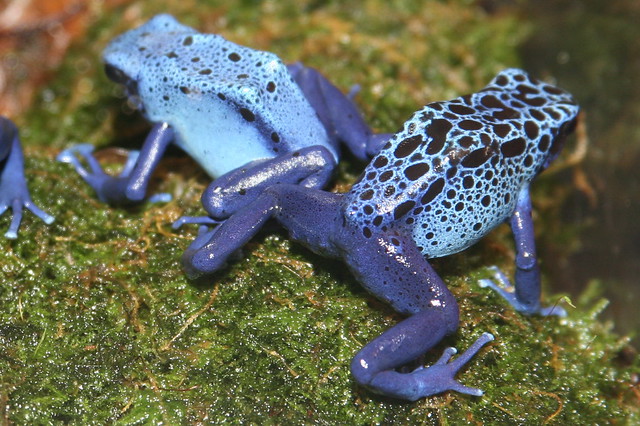 |
| Photo by cliff1066™ |
Recognizing Poison Dart Frogs
Poison Dart Frogs can display colors of red, blue, green, yellow, black, gold, or copper. They flaunt vibrant colors in flamboyant designs that are useful in turning away potential predators.
Scientifically, this is called aposematic coloration, which basically is when coloration is used to scare off predators. Poison Dart Frogs are very small; they are normally no longer than an inch, with few exceptions.
Reproduction
The female poison dart frog places her eggs either on land or other suitable places, such as a leaf upon completion of the mating ritual. Poison Dart Frogs' mating ritual begins with the male vocalizing a sort of mating call until a suitable female is attracted. The eggs are enveloped by a sticky, gel-like substance that is similar to jelly, and they will remain there for two weeks. The eggs are regularly checked on by a parent, though it is typically the male who assumes this task. This has to be done to ensure they don't dry out, as the parent will moisten them during each visit.
After the two weeks, the newly hatched tadpoles will be transferred onto the back of a parent... again this is normally the male. They are transported on the back, safely kept in place by a secretion that prevents them slipping off. The tadpole Poison Dart Frogs are taken to a new location such as puddles, car tires, tree holes, bromeliad, or anywhere that offers a small, wet area. This is the point where the parent leaves, and the tadpoles are left to continue growing and developing.
Toxicity
Not every species of Poison Dart Frogs are toxic, but there are some that are exceptionally toxic, and even fatal. The most toxic of the Poison Dart Frogs are the Phyllobates terribilis of Colombia. It's a bright yellow in color, and you can be harmed by simply touching it. The local population captures these frogs and drags their blowgun darts along the surface of their body to coat them in the poison, and then releases them.
Poison Dart Frogs as a pet frog?
Though you may think this, it is becoming more and more common. Poison Dart Frogs that are captive bred are non-toxic. They may not be the best suitable species if this is going to be your first pet frog, but they are far from the most difficult to care for. Poison Dart Frogs provide a beautiful addition to your home with their spectacular colorations and inhabitant. In captivity, a Poison Dart pet frog can live up to 15 years.

No comments:
Post a Comment